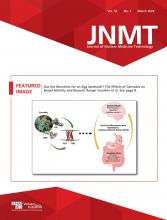Abstract
PET/CT radiotracer infiltrations are not uncommon and often outside imaging fields of view. Infiltrations can negatively impact image quality and quantification, and can adversely affect patient management. Until recently, there has not been a simple way to routinely practice PET radiopharmaceutical administration quality control/quality assurance (QC/QA). Our objectives were to quantify infiltration rates, determine associative factors for infiltrations, and to assess if rates could be reduced and sustained at multiple centers. Methods: A Design, Measure, Analyze, Improve, Control quality improvement (QI) methodology requiring novel technology was used to try to improve PET/CT injection quality. Teams were educated on the importance of quality injections. Baseline infiltration rates were measured, center-specific associative factors were analyzed, team meetings were held, improvement plans were established and executed, and rates remeasured. To ensure injection quality gains were retained, real-time feedback and ongoing monitoring were used. Sustainability was assessed. Results: Seven centers and 56 technologists provided data on 5,541 injections. The centers’ aggregated baseline infiltration rate was 6.2% (range 2% - 16%). Based on their specific associative factors, four centers developed improvement plans and reduced their aggregated infiltration rate from 8.9% to 4.6% (P < 0.0001). On-going injection monitoring showed sustainability. Significant center- and technologist-level infiltration rate variation was found (P < 0.0001 and P = 0.0020). Conclusion: A QI approach with new technology can help centers measure infiltration rates, determine associative factors, implement interventions, and improve/sustain injection quality. Since PET/CT images help guide patient management, monitoring and improving radiotracer injection quality is important.
Footnotes
Immediate Open Access: Creative Commons Attribution 4.0 International License (CC BY) allows users to share and adapt with attribution, excluding materials credited to previous publications. License: https://creativecommons.org/licenses/by/4.0/. Details: http://jnm.snmjournals.org/site/misc/permission.xhtml.







